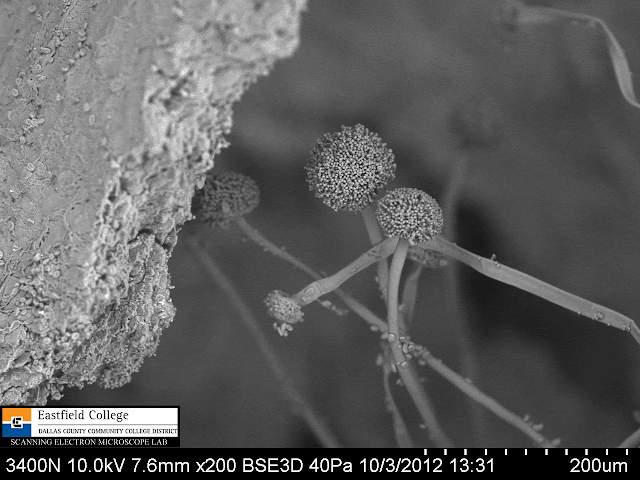I normally don't follow up one blog posting with another on the same topic, but my students began a slide culture of two species of fungi last week and we got to see the results in lab today.
The procedure is pretty simple. Students use a well (depression) slide and cover slip to make the culture. Both slide and cover slip are dipped in ethyl alcohol and then passed through the flame of a Bunsen burner to sterilize them.
A thin line of Petroleum jelly is applied to three sides of the depression. Then one or two drops of melted Sabourand agar is added to the well and covered with the cover slip. The slide is allowed to cool on its side with the non-petroleum jelly edge up. This makes a thin reservoir of agar with an air pocket at the top.
Once the agar has solidified, the cover slip is slide down so the agar can be inoculated with the spores for the test culture. Put the cover slip back on and place in a Petri dish containing damp filter paper (use something to keep the slide above the filter paper). Place in an incubator at 25 degrees C for one week and then check the results. (The procedure can be found in the Pearson microbiology lab book called Symbiosis)
This allows you to use a light microscope to see the delicate structures of the fungi without disturbing them.
The first set of images are Saccharomyces cerevisiae - yeast.
 Living yeast cells at 400x taken with a Leica microscope with a digital camera attached. The red arrows show budding, an asexual process in which the parent cell copies it nucleus and then the bud, or daughter cell, grows out of the side of the parent cell.
Living yeast cells at 400x taken with a Leica microscope with a digital camera attached. The red arrows show budding, an asexual process in which the parent cell copies it nucleus and then the bud, or daughter cell, grows out of the side of the parent cell. Living yeast cells at 1000x (oil immersion). A closer look at some buds. Notice the nuclei of the cells.
~~~~~~~~~~~~~~~~~~~~~~~~~~~~~~~~~~~~~~~~~~~~~~~~~~~~~~~~
The second set of images are of Penicillium chrysogenum (AKA P. notatum). Penicillium is an ascomycota.

This first image, taken at 1000x with immersion oil, shows a germinating conidia spore.
Penicillium at 400x. This one is a bit farther along and includes a conidiophore and conidia.
Living hyphae at 1000x (oil immersion). This is a closer look at some of the the septa that separate the cells of the hyphae.
A conidiophore and conidia at 1000x (oil immersion).
Adding a digital camera to the instructor's microscope in a microbiology class has been wonderful. When I was but a wee laddy back in my high school and college biology classes, digital technology hadn't been invented. (Yes, I am old.) It it amazing to be able to show my students live images of samples in lab and to be able to capture those images.
With a steady hand and some patience, you can take an image directly through the eyepiece of a microscope with any smart phone or digital camera.( If you are a teacher, just tell your students it can be done and they will have it figured out in about 2 minutes.) In my lab I built a camera mount out of a tripod and old mechanical stage which lets me easily position the camera and keep it in place. This is especially useful on a binocular scope where you can dedicate one eyepiece to the camera.
Feel free to link to out blog. Our Creative Commons licence allows you to copy, use, and modify any image just as long as you give credit to Eastfield College don't use images for commercial purposes.
Microscopy Lab Coordinator
Eastfield College
Mesquite, TX













.gif)





.gif)
.gif)
















.gif)
.gif)



